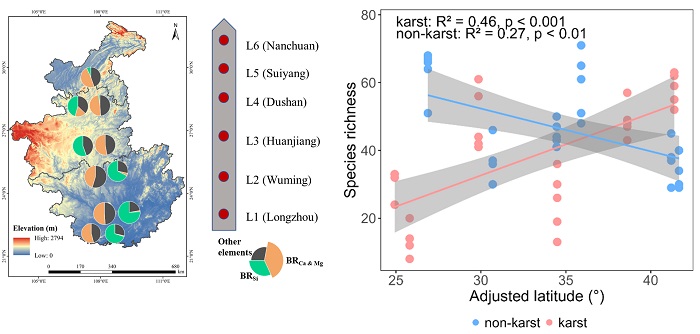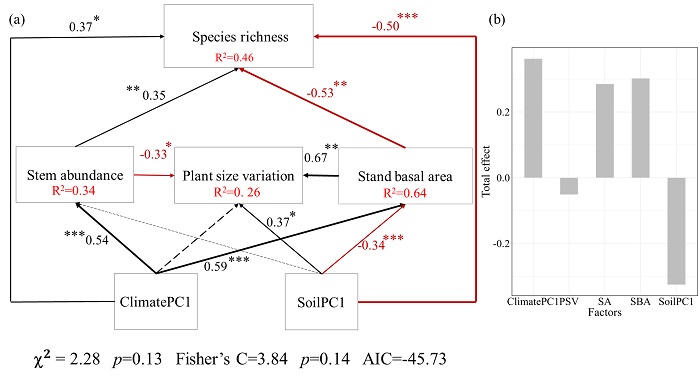Calcium Rich Karst Bedrock Reshapes the Latitudinal Pattern of Forest Species Diversity
A new study led by Prof. Chen Hongsong at the Institute of Subtropical Agriculture, Chinese Academy of Sciences, has revealed that calcium rich bedrock can reshape the latitudinal diversity gradient (LDG) within karst forests. These findings provide empirical evidence that geodiversity can modulate or even overturn the traditional LDG by altering soil formation and nutrient availability.
The study was published in Diversity and Distributions on Oct 6.
Plant diversity typically decreases toward higher latitudes, a pattern known as the LDG, which has long been regarded as a fundamental rule in ecology and biogeography. However, this traditional pattern can be modified by geological factors, particularly in karst landscapes where calcium rich bedrock strongly influences soil formation and nutrient availability. In this new study, whether and how bedrock-soil properties influence LDGs were investigated by comparing two contrasting bedrock types, karst and non-karst forests. Their results provide clear evidence that bedrock type reshapes LDG within karst forest ecosystems.
Through a 10° latitudinal transect across subtropical China, encompassing six nature reserves and 60 paired karst and non-karst forest plots, a total of 654 woody species and 17,740 individuals were recorded. By integrating vegetation surveys, bedrock geochemical analysis, soil physicochemical properties, and structural equation modeling (SEM), the team quantitatively assessed the coupled effects of climate and bedrock-soil properties on LDGs.
The results revealed significant differences in bedrock-soil properties under similar climatic settings. Karst forests had lower SiO₂ content in bedrock and shallower soil depths but higher calcium- and magnesium- related concentrations (SoilPC1). These environmental factors also showed significantly latitudinal gradient in karst regions: both bedrock SiO₂ content and soil depth increased toward higher latitudes, whereas SoilPC1 decreased.
Importantly analysis linked to forest diversity exhibited opposite latitudinal trends between the two geological settings. In non-karst forests, species diversity declined with latitude, consistent with the traditional LDG. In contrast, karst forests showed increasing diversity toward higher latitudes, forming an inverse LDG pattern. SEM analysis further revealed that the positive climatic effects on diversity (total effect = 0.22) was offset or even reversed by the strong negative effects of SoilPC1 (total effect = −0.33), indicating that the restrictive properties of karst soils are the key drivers of this pattern reversal.
Moreover, species diversity in karst forests was strongly correlated with bedrock SiO₂ content (R²=0.71), soil depth (R²=0.36), and SoilPC1 (R²=0.19), suggesting a tight coupling between geological heterogeneity and species diversity.
It establishes a mechanistic framework linking bedrock chemistry, soil environment, and plant community diversity, offering new insights into the geological controls of biodiversity distribution worldwide. “Geological diversity should be considered in biodiversity conservation and ecological restoration strategies”, Profs Nie Yunpeng and Chen Hongsong, the corresponding authors emphasized, “especially in climatically sensitive karst regions.”
Contacted: Nie Yunpeng and Chen Hongsong
EMail: nyp@isa.ac.cn & hbchs@isa.ac.cn

Figure1 Locations of the transect and relationships between species diversity and latitude within karst and non-karst forests, respectively(Imaged by Hunag Li)

Figure2 Effects of climate and bedrock-soil properties on species diversity within the entire transect(Imaged by Hunag Li)
Download attachments: